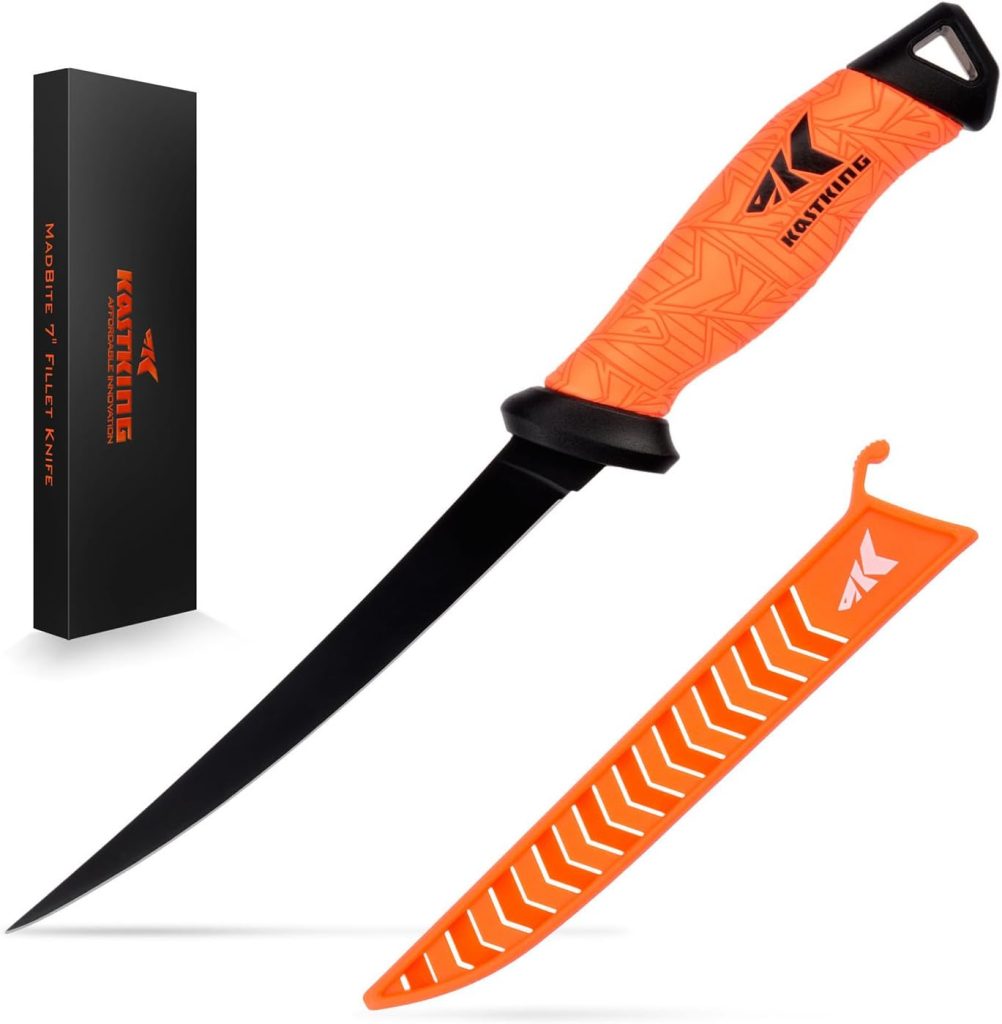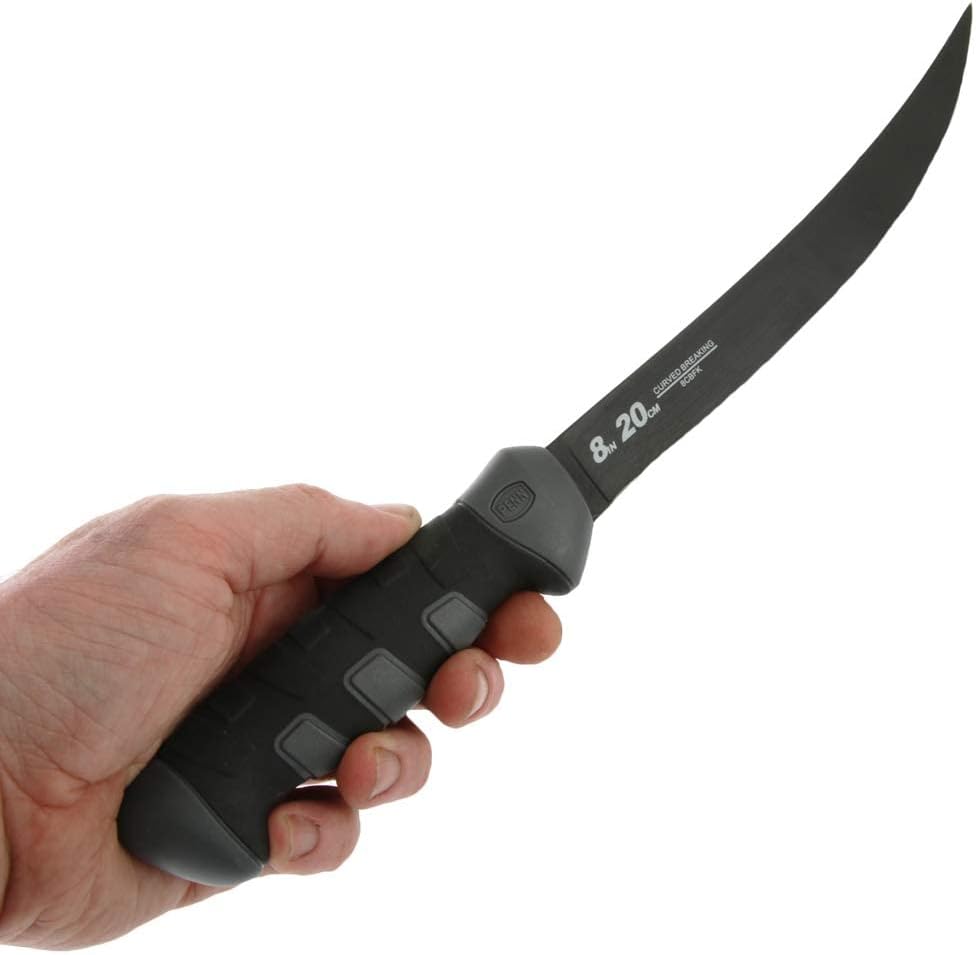Introducing the angler’s best companion for precision and efficiency: the ultimate fillet knife designed specifically for cleaning fish. With its razor-sharp blade and ergonomic design, this indispensable tool streamlines the fish cleaning process, making it quicker and more precise than ever before. Whether you’re a seasoned angler or a novice fisherman,Best Fillet Knives are sure to become your go-to choice for effortlessly preparing your catch of the day.
Best Fillet Knives We Will Cover Today
1.KastKing Fillet Knife and Bait Knife
2.BUBBA Li-Ion Cordless Electric Fillet Knife
3.Penn Saltwater Fishing knife
4.Rapala Heavy Duty Electric Fillet Knife
5.Dalstrong Fillet Knife – 7 inch Flexible Blade
Fillet Knives Reviews!
1.KastKing Fillet Knife and Bait Knife
5.Dalstrong Fillet Knife – 7 inch Flexible Blade
Crafted with precision and durability in mind, the Dalstrong Fillet Knife is a standout addition to any kitchen or angler’s toolkit. Boasting a 7-inch flexible blade made from high-carbon German steel, this knife ensures razor-sharp cuts with every use.
The flexibility of the blade allows it to effortlessly glide along the contours of fish, maximizing meat yield while minimizing waste. Whether you’re filleting delicate trout or hefty salmon, this knife delivers consistent results.
The ergonomic design of the knife, featuring a black G10 handle, provides exceptional grip and control. Even in wet conditions, the non-slip handle ensures safe and precise handling, reducing the risk of accidents.
The knife comes with two sheaths, providing convenient storage and protection. Whether you’re storing it in a drawer or taking it on a fishing trip, the sheaths keep the blade safe and secure.
With NSF certification, the Dalstrong Fillet Knife meets rigorous standards for quality and safety. This certification ensures peace of mind, knowing that the knife is built to the highest industry standards.
Pros:
- High-Quality Blade: Made from high-carbon German steel, ensuring durability and razor-sharp performance.
- Flexible Blade: Allows for precise filleting, maximizing meat yield.
- Ergonomic Handle: Black G10 handle provides excellent grip and control, even in wet conditions.
- Two Sheaths: Comes with two sheaths for convenient storage and protection.
- NSF Certified: Meets rigorous standards for quality and safety.
Cons:
- Price: Higher price point compared to some other fillet knives.
- Maintenance: Requires regular sharpening to maintain peak performance.
- Limited Versatility: Primarily designed for filleting, may not be suitable for other tasks.
- Handle Design: Some users may find the handle design uncomfortable depending on their hand size and grip preference.
- Sheath Quality: While convenient, the sheaths may not be as durable as some users would prefer.
Things to Consider When Buying a Fillet Knife
When selecting a fillet knife for cleaning fish, several factors come into play to ensure you find the perfect tool for the job. Here’s a comprehensive buying guide to help you make an informed decision:
Blade Material:
Look for blades made from high-quality stainless steel or carbon steel. These materials offer excellent durability, corrosion resistance, and edge retention.
Blade Length:
Choose a blade length based on the size of fish you typically clean. For smaller fish, a blade around 6 inches may suffice, while larger fish may require a blade of 9 inches or more for optimal efficiency.
Blade Flexibility:
Opt for a fillet knife with a flexible blade, as this allows for precise cuts and better maneuverability around bones and contours of the fish.
Handle Design:
Consider the ergonomics of the handle design for comfort and control during prolonged use. Look for features such as non-slip grip and contoured shapes that fit comfortably in your hand.
Tang:
Choose a fillet knife with a full tang, where the blade extends through the entire length of the handle. Full tang knives provide better balance, stability, and durability compared to partial tang or rat-tail tang designs.
Maintenance:
Check if the knife is easy to clean and maintain. Look for models that are dishwasher safe or can be easily hand washed with mild soap and water. Additionally, consider knives that are easy to sharpen to maintain optimal cutting performance.
Versatility:
Consider whether you need a fillet knife that can handle both freshwater and saltwater fish. Look for models with corrosion-resistant materials and durable construction suitable for various fishing environments.
Brand Reputation and Warranty:
Research reputable brands known for producing high-quality fillet knives. Check customer reviews and testimonials to gauge user satisfaction. Additionally, look for knives backed by a warranty to ensure peace of mind and protection against defects.
Budget:
Set a budget based on your preferences and requirements. While there are fillet knives available at various price points, prioritize quality and performance over price to ensure a reliable and long-lasting investment.
How do you sharpen fish fillet knives?
Sharpening a fish fillet knife is crucial for maintaining its cutting performance and ensuring clean, precise cuts. Here’s a step-by-step guide on how to sharpen a fish fillet knife:
- Gather Your Sharpening Tools:
- You will need a sharpening stone or sharpening rod to sharpen your fillet knife. There are various types of sharpening stones available, including water stones, oil stones, and diamond stones. Choose the one you’re most comfortable with.
- Additionally, you might need honing oil if you’re using a traditional sharpening stone (water stones and diamond stones don’t require oil).
- Prepare the Sharpening Surface:
- Place your sharpening stone on a flat, stable surface. Make sure it won’t move or slip while you’re sharpening your knife.
- Angle of the Blade:
- Determine the angle of the blade. For most fillet knives, a 15 to 20-degree angle works well. You can find this angle by placing the blade on the stone and lifting the spine until you reach the desired angle.
- Apply Honing Oil (if using):
- If you’re using a traditional sharpening stone that requires honing oil, apply a few drops of oil to the stone’s surface. This helps lubricate the stone and facilitates smoother sharpening.
- Start Sharpening:
- Hold the knife with the blade facing away from you and the cutting edge against the stone.
- With a consistent motion, move the blade across the stone, starting from the base of the blade towards the tip. Maintain the chosen angle throughout the process.
- Use light to moderate pressure and make several passes on each side of the blade. Aim for an equal number of strokes on each side to maintain balance.
- Check Your Progress:
- After a few passes, check the blade for burrs or imperfections. A burr is a thin strip of metal that forms along the edge of the blade when sharpening.
- Run your fingertip gently along the edge to feel for any burrs. If you detect any, continue sharpening until they are removed, and the edge feels smooth.
- Switch Sides:
- Flip the knife over and repeat the sharpening process on the other side of the blade. Again, maintain the same angle and apply even pressure.
- Hone the Edge (optional):
- Once you’ve sharpened both sides of the blade, you can hone the edge using a leather strop or a honing rod. This helps refine the edge and remove any remaining burrs.
- Hold the knife at the same angle as before and lightly stroke the edge along the strop or honing rod several times on each side.
- Test the Sharpness:
- Finally, test the sharpness of your knife by gently slicing through a piece of paper or by making a few cuts on a tomato or other soft produce. The blade should cut smoothly and effortlessly.
- Clean Your Knife:
- After sharpening, thoroughly clean your knife to remove any metal particles or residue. Rinse the blade under running water and dry it completely with a clean towel.
What are fish fillet knives used for?
Fish fillet knives are primarily used to remove the skin, bones, and entrails from fish to obtain boneless fillets of meat. These knives have thin, flexible blades that are perfect for making precise cuts along the fish’s body, separating the fillet from the bone structure while minimizing waste.
They are also handy for removing scales from the fish’s skin before filleting. The sharp blade of a fillet knife can easily scrape away scales without damaging the underlying flesh.
After filleting, fish fillet knives can be used to remove the skin from the fillet. The sharp blade allows for clean, precise cuts to separate the skin from the flesh.
They are useful for trimming excess fat or uneven edges from fillets, ensuring uniformity in the final product.
While not as effective as boning knives for larger bones, fish fillet knives can be used to remove smaller pin bones from fish fillets.
Outside of fish preparation, fish fillet knives can be used for various kitchen tasks, such as slicing vegetables, deboning poultry, or trimming meat.
FAQs
1. How long does the blade stay sharp?
Answer:The longevity of the blade’s sharpness depends on factors such as frequency of use, the type of fish being cleaned, and maintenance. However, our fillet knife is crafted from high-quality materials designed to retain sharpness over multiple uses.
2. Is the handle comfortable to hold for extended periods?
Answer:Yes, absolutely! We understand the importance of comfort during prolonged use. That’s why our fillet knife features an ergonomic handle design that provides a secure and comfortable grip, reducing fatigue even during extended fish cleaning sessions.
3. Can the knife handle different types and sizes of fish?
Answer: Yes, our fillet knife is versatile enough to handle a wide range of fish species and sizes. Whether you’re cleaning small panfish or large game fish, the precision and flexibility of our blade make it suitable for various fish cleaning tasks.
4. How should I care for and maintain my fillet knife?
Answer:Proper maintenance is crucial for preserving the sharpness and longevity of your fillet knife. After each use, we recommend handwashing the knife with mild soap and water, then thoroughly drying it to prevent corrosion. Additionally, occasional sharpening with a quality knife sharpener will help maintain optimal performance.
5. Is the fillet knife suitable for both freshwater and saltwater fish?
Answer: Absolutely! Our fillet knife is designed to withstand the rigors of both freshwater and saltwater environments. Its corrosion-resistant materials ensure durability and longevity, making it an ideal choice for cleaning fish in any setting.
Final words
In conclusion, investing in the best fillet knife for cleaning fish is a game-changer for any angler. With its unmatched precision, durability, and ease of use, this essential tool ensures that every fish cleaning session is efficient and enjoyable. Say goodbye to struggling with dull blades and awkward angles—make the smart choice and elevate your fishing experience with the ultimate fillet knife.
- This gift set includes:
- 7" Fillet Knife with Sheath
- Fish Ugly Vacuum Insulated Stainless Steel Tumbler
- Country of Origin: China





